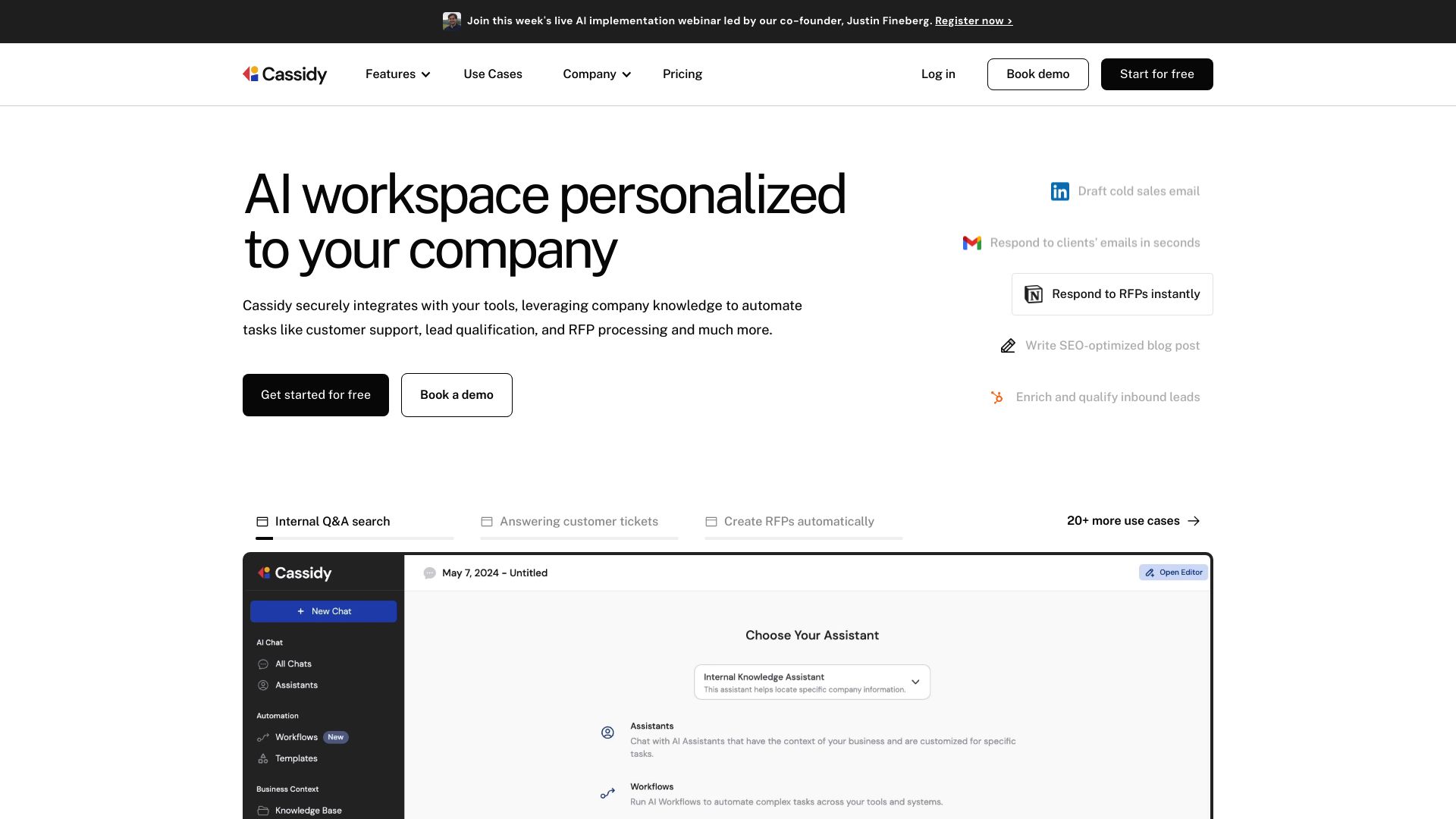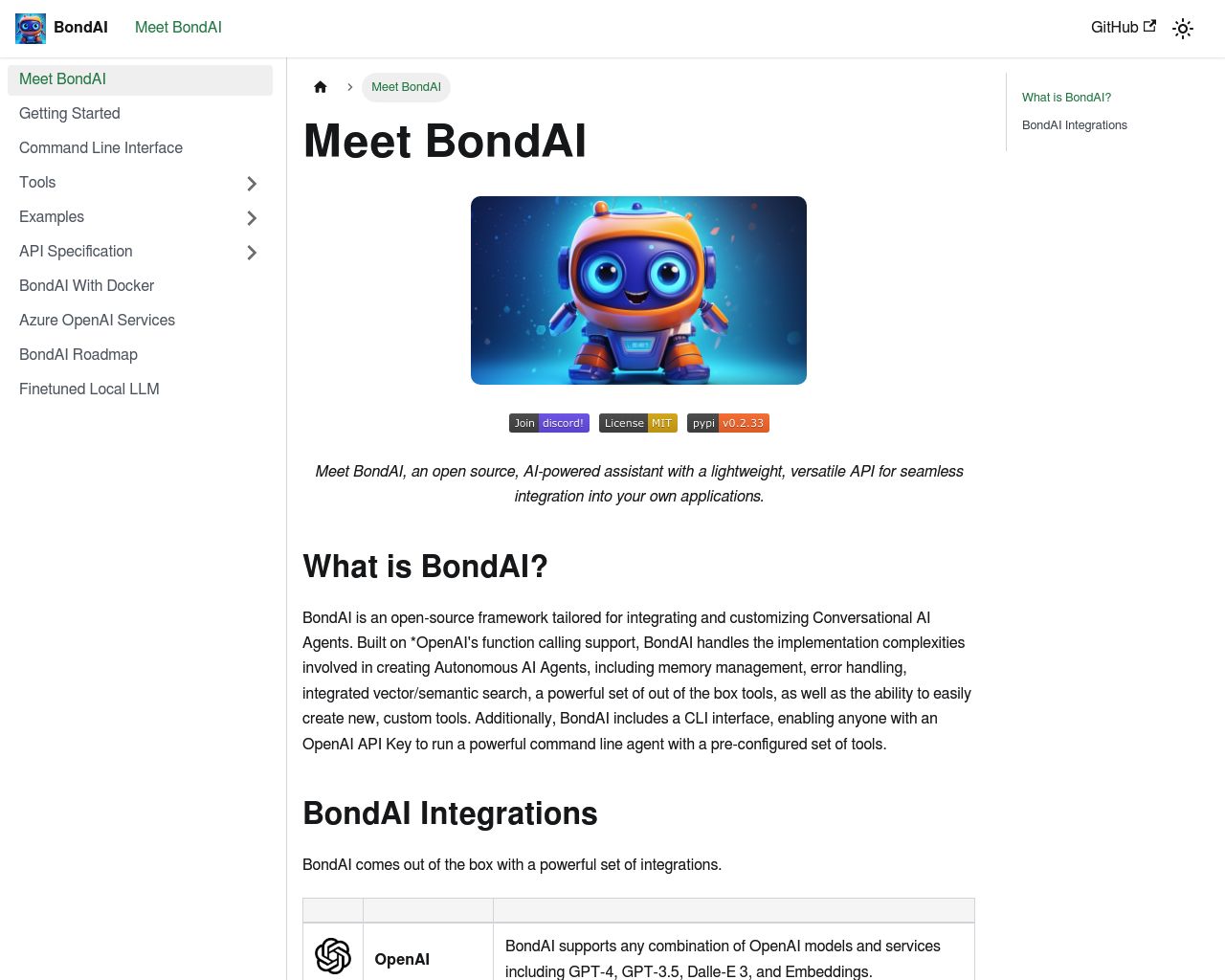Cassidy vs. BondAI: Comparing AI Development Platforms
AI agent development platforms have revolutionized how businesses harness advanced technologies. SmythOS, Cassidy, and BondAI each bring unique strengths to the table, catering to diverse user needs. This comparison examines their core features, usability, and potential applications. We’ll explore how SmythOS’s intuitive interface and comprehensive toolkit stack up against Cassidy’s business-focused automations and BondAI’s open-source flexibility. Whether you’re a developer seeking customization, a business leader looking for scalable solutions, or a non-technical user aiming to leverage AI, this analysis will guide you through the key considerations for choosing the right platform to power your AI initiatives.
Cassidy Overview
Cassidy empowers businesses to harness AI through customizable assistants and workflows. The platform integrates company knowledge and existing tools to automate tasks like customer support, lead qualification, and RFP processing. Cassidy’s no-code approach allows users to build sophisticated AI solutions without programming expertise.
Cassidy empowers businesses to harness AI through customizable assistants and workflows … to automate tasks like customer support, lead qualification, and RFP processing.


Cassidy’s key features include a model-agnostic approach, seamless integration with data sources like Google Drive and Slack, and enterprise-grade security measures. The platform’s user-friendly workflow builder enables complex AI automations through a drag-and-drop interface. Cassidy also offers browser extensions, bringing AI capabilities directly into web applications such as LinkedIn and email clients.
Cassidy’s key features include a model-agnostic approach, seamless integration with data sources like Google Drive and Slack, and enterprise-grade security measures.
The platform excels in creating AI assistants that handle diverse tasks, from email responses to market research. Its workflow builder automates processes like real-time data scraping, knowledge base searches, and text generation. Cassidy prioritizes data security, ensuring confidentiality by never using client data for model training.
While Cassidy offers robust features for AI automation, it lacks some advanced capabilities. The platform doesn’t explicitly mention multimodal support, debug modes, or hosted vector databases. These limitations may impact users requiring more specialized or technical functionalities. Despite these constraints, Cassidy’s focus on accessibility and business integration positions it as a valuable tool for organizations seeking to leverage AI without extensive technical resources.
BondAI Overview
BondAI offers an open-source framework for developing advanced AI Agent Systems. The platform simplifies complex aspects of autonomous AI agent creation, including memory management, error handling, and semantic search capabilities.


BondAI supports cutting-edge AI architectures like ReAct Agents and ConversationalAgents, enabling both individual interactions and multi-agent systems. This versatility allows for collaborative problem-solving that surpasses single-agent models. The framework integrates seamlessly with popular services such as OpenAI models, Microsoft Azure, Google Search, and tools like LangChain, expanding its application range from research to trading and customer support.
BondAI offers an open-source framework for developing advanced AI Agent Systems. The platform simplifies complex aspects of autonomous AI agent creation, including memory management, error handling, and semantic search capabilities.
A standout feature of BondAI is its robust memory management system, inspired by the MemGPT paper. Using a tiered approach with core, conversation, and archival memory, BondAI efficiently manages extensive contexts and complex conversations. This structure enhances the agents’ problem-solving capabilities and information retrieval.
A standout feature of BondAI is its robust memory management system… Using a tiered approach with core, conversation, and archival memory, BondAI efficiently manages extensive contexts and complex conversations.
BondAI’s flexibility shines through its multiple deployment options. Users can access the toolkit via a Command Line Interface, Docker containers, or direct integration into codebases. This adaptability allows for quick starts with pre-configured tools or custom agent development, catering to various skill levels and project requirements.
While BondAI offers powerful features, it may present a steeper learning curve for non-technical users compared to some no-code platforms. Its open-source nature, however, provides transparency and customization opportunities that closed systems lack. For developers and researchers seeking to build advanced AI-driven applications, BondAI’s combination of cutting-edge research implementation and extensive tool integration makes it a compelling choice in the AI agent builder landscape.
Feature Comparison
SmythOS and BondAI offer robust AI agent development capabilities, but with distinct approaches and feature sets. SmythOS provides a comprehensive no-code platform with an intuitive drag-and-drop interface, making AI agent creation accessible to users of all technical backgrounds. In contrast, BondAI delivers an open-source framework that caters to developers and researchers, offering more flexibility for custom implementations.
A key differentiator is SmythOS’s hosted solution, which includes development and production environments, simplifying deployment and scaling. BondAI, while powerful, requires more technical expertise to set up and manage infrastructure. SmythOS also excels in security features, offering data encryption, OAuth integration, and IP control out-of-the-box. BondAI’s open-source nature allows for custom security implementations but doesn’t provide these features by default.
In terms of core components, SmythOS offers a wider range of pre-built integrations, including Zapier APIs and various AI models. BondAI focuses on providing a flexible foundation for integrating different AI architectures but may require more effort to connect with external services. While both platforms support multi-agent systems, SmythOS’s visual builder and pre-configured templates make it easier to orchestrate complex agent interactions without extensive coding.
Feature Comparison Table
| Cassidy | BondAI | SmythOS | |
|---|---|---|---|
| CORE FEATURES | |||
| Visual Builder | ✅ | ❌ | ✅ |
| No-Code Options | ✅ | ❌ | ✅ |
| Autonomous Agents | ❌ | ✅ | ✅ |
| Explainability & Transparency | ❌ | ✅ | ✅ |
| Multimodal | ❌ | ✅ | ✅ |
| Multi-Agent Collaboration | ❌ | ✅ | ✅ |
| Audit Logs for Analytics | ❌ | ❌ | ✅ |
| SECURITY | |||
| Constrained Alignment | ✅ | ❌ | ✅ |
| IP Control | ❌ | ❌ | ✅ |
| COMPONENTS | |||
| Huggingface AIs | ❌ | ✅ | ✅ |
| Classifiers | ❌ | ✅ | ✅ |
| Data Lakes | ❌ | ❌ | ✅ |
| DEPLOYMENT OPTIONS (EMBODIMENTS) | |||
| Staging Domains | ❌ | ❌ | ✅ |
| Production Domains | ❌ | ✅ | ✅ |
| API Authentication (OAuth + Key) | ❌ | ✅ | ✅ |
| Deploy as Site Chat | ❌ | ✅ | ✅ |
| Deploy as Scheduled Agent | ✅ | ❌ | ✅ |
| Deploy as GPT | ❌ | ✅ | ✅ |
| DATA LAKE SUPPORT | |||
| Hosted Vector Database | ❌ | ❌ | ✅ |
| Sitemap Crawler | ❌ | ❌ | ✅ |
| YouTube Transcript Crawler | ❌ | ❌ | ✅ |
| URL Crawler | ❌ | ✅ | ✅ |
Best Alternative to Cassidy and BondAI
SmythOS emerges as the superior alternative to Cassidy and BondAI for AI agent development and deployment. Our platform combines powerful features with unparalleled ease of use, making advanced AI capabilities accessible to users of all skill levels.
Unlike Cassidy’s limited autonomous capabilities or BondAI’s developer-focused approach, SmythOS offers a comprehensive visual builder that simplifies complex AI workflows. Users create sophisticated agents through intuitive drag-and-drop interfaces, eliminating the need for extensive coding knowledge. This democratization of AI development sets SmythOS apart, enabling rapid iteration and deployment of AI solutions across various use cases.
SmythOS offers a comprehensive visual builder that simplifies complex AI workflows. Users create sophisticated agents through intuitive drag-and-drop interfaces, eliminating the need for extensive coding knowledge.
SmythOS excels in its extensive integration ecosystem. While Cassidy and BondAI offer some API connections, our platform provides seamless integration with a vast array of services, including Zapier, Hugging Face models, and custom APIs. This expansive connectivity empowers users to build AI agents that interact effortlessly with existing tools and data sources, enhancing productivity across diverse business processes.
Security and scalability form cornerstones of the SmythOS platform. We offer robust features like data encryption, OAuth integration, and IP control out-of-the-box, addressing enterprise-grade security concerns that Cassidy and BondAI may overlook. Our hosted solution, complete with development and production environments, simplifies deployment and scaling, allowing businesses to grow their AI capabilities without infrastructure headaches.
The multi-agent collaboration capabilities of SmythOS surpass those of its competitors. While BondAI supports some multi-agent systems, our platform’s visual orchestration tools make it remarkably simple to design and deploy teams of AI agents that work together seamlessly. This collaborative approach opens up new possibilities for tackling complex, multi-faceted problems that single agents struggle to solve efficiently.
Conclusion
Cassidy, BondAI, and SmythOS each offer unique approaches to AI agent development, catering to different user needs and technical expertise levels. Cassidy provides a user-friendly platform for businesses to create customized AI assistants without extensive coding knowledge. BondAI offers an open-source framework that gives developers and researchers flexibility in building advanced AI systems. SmythOS, however, stands out by combining the best of both worlds.
SmythOS excels with its intuitive drag-and-drop interface and extensive integration ecosystem, making AI development accessible to users of all skill levels. Unlike Cassidy and BondAI, SmythOS offers a comprehensive solution that includes both development and production environments, simplifying the entire process from creation to deployment. The platform’s support for multi-agent orchestration and versatile deployment options surpasses the capabilities of its competitors.
While Cassidy and BondAI have their strengths, SmythOS’s combination of ease-of-use, advanced features, and scalability makes it the superior choice for businesses and developers looking to harness the full potential of AI. SmythOS not only simplifies AI agent creation but also provides the tools necessary for complex, enterprise-level implementations.
To experience the power and flexibility of SmythOS firsthand, create a free SmythOS account today. Start building your own AI agents with our intuitive platform and explore our diverse range of AI-powered agent templates to jumpstart your projects. Whether you’re a seasoned developer or new to AI, SmythOS empowers you to revolutionize your workflow and unlock new possibilities in AI automation.
Last updated:
Disclaimer: The information presented in this article is for general informational purposes only and is provided as is. While we strive to keep the content up-to-date and accurate, we make no representations or warranties of any kind, express or implied, about the completeness, accuracy, reliability, suitability, or availability of the information contained in this article.
Any reliance you place on such information is strictly at your own risk. We reserve the right to make additions, deletions, or modifications to the contents of this article at any time without prior notice.
In no event will we be liable for any loss or damage including without limitation, indirect or consequential loss or damage, or any loss or damage whatsoever arising from loss of data, profits, or any other loss not specified herein arising out of, or in connection with, the use of this article.
Despite our best efforts, this article may contain oversights, errors, or omissions. If you notice any inaccuracies or have concerns about the content, please report them through our content feedback form. Your input helps us maintain the quality and reliability of our information.
